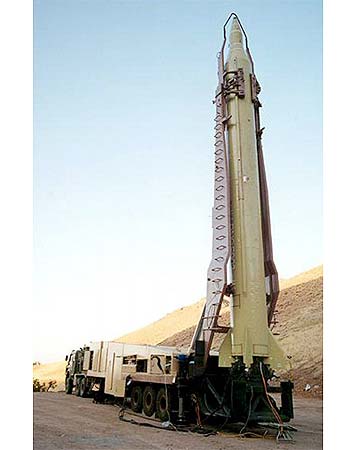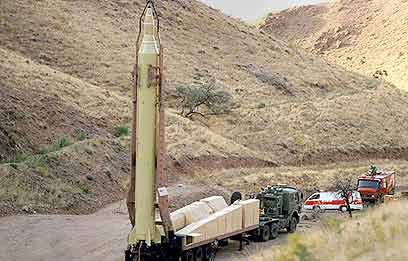http://www.fresh.co.il/dcforum/Army/11067.html
Agni-III will be ready for test soon
Agni-III, the most powerful ballistic missile developed by India, will be ready for its first test soon but a decision on the launch would have to be taken by the government, the country's top defence scientist has said.
"Agni-III is undergoing the final phase of integration. It will be ready for trials soon," V.K. Aatre, chief of the Defence Research and Development Organisation (DRDO) and scientific advisor to the defence minister, said here Wednesday.
"But the timing (of the test) has not been decided since it is much more than technology."
Agni-III, an intermediate range ballistic missile being developed by DRDO, has a range of 3,000 km. This would allow it to strike at targets deep within China.
Aatre, who will retire this month-end after 25 years of association with defence research and development organisations, said India had come of age in missile technologies though field trials and induction of various missiles were delayed by sanctions and embargoes on critical components and sub-systems.
"Agni-I and Agni-II surface-to-air missiles with a range of 1,000 km to 2000 km have already been inducted into the Indian Army, while the Indian Navy has begun inducting the BrahMos cruise missiles with a strike range of 300 km on some of its frontline destroyers and frigates," Aatre told a "meet the press programme" organised by the Bangalore Press Club.
Asked whether the Agni-III trial would be held this year, as hinted by him earlier, Aatre said it was up to his successor to decide the timing in consultation with the government.
"I will not be able to give a specific time table for the test firing as I am laying down office in the next 10 to 12 days. You have to wait for some more time," Aatre said.
The medium and short range missiles Aakash and Nag will also be inducted in the army and Indian Air Force (IAF) after completing field and user trials later this year.
"The 25-km Akash missile is meant to replace the aging SAM-6 used by the army and SAM-3 used by the IAF. The anti-missile system will be able to effectively counter any short-range ballistic missiles launched by the enemy," Aatre said.
In the case of the army, the missile will be able to match the anti-tank guided missile of Pakistan's TOW-II tanks with a 4-km range.
With a much faster reaction time, the air force version can engage any combat aircraft cruising at Mach 3 speed and intercept it quickly.
The Akash missiles are being developed by Bangalore-based DRDO in collaboration with other defence and private institutions as part of the Integrated Guided Missile Development Programme.
Referring to the development of multiple radars for the three services, Aatre said the Electronics and Radar Development Establishment (LRDE) and Bharat Electronics Ltd (BEL), both based in Bangalore, have successfully developed a weapon locating radar that will be sent for trials in the next six months.
"In spite of sanctions and denial of critical components, India has achieved a degree of self-reliance in radar technologies to develop various radars, including three-dimensional ones," Aatre said.
Aatre took over as DRDO chief from A.P.J. Abdul Kalam in 1991, who became scientific advisor to the Prime Minister and president of India subsequently.
Expressing satisfaction at the successful completion of his favourite project -- the development of the indigenous Light Combat Aircraft (LCA) -- and its 60 flawless test flights till date, Aatre said the supersonic fighter would be inducted into the IAF by 2007-08 in a limited series.
"The indigenous Kaveri engine for the LCA, developed by the Gas Turbine Research Establishment, has been sent to Russia for advance testing after overcoming some design problems.
"All going well, we will mount the Kaveri on the LCA by 2006-07 for flight tests. Though we are behind by a couple of years in developing it fully, its production in the near future will enable India to market the LCA to the world as the lightest and cheapest fighter jet," Aatre said.
Agni-III will be ready for test soon
Agni-III, the most powerful ballistic missile developed by India, will be ready for its first test soon but a decision on the launch would have to be taken by the government, the country's top defence scientist has said.
"Agni-III is undergoing the final phase of integration. It will be ready for trials soon," V.K. Aatre, chief of the Defence Research and Development Organisation (DRDO) and scientific advisor to the defence minister, said here Wednesday.
"But the timing (of the test) has not been decided since it is much more than technology."
Agni-III, an intermediate range ballistic missile being developed by DRDO, has a range of 3,000 km. This would allow it to strike at targets deep within China.
Aatre, who will retire this month-end after 25 years of association with defence research and development organisations, said India had come of age in missile technologies though field trials and induction of various missiles were delayed by sanctions and embargoes on critical components and sub-systems.
"Agni-I and Agni-II surface-to-air missiles with a range of 1,000 km to 2000 km have already been inducted into the Indian Army, while the Indian Navy has begun inducting the BrahMos cruise missiles with a strike range of 300 km on some of its frontline destroyers and frigates," Aatre told a "meet the press programme" organised by the Bangalore Press Club.
Asked whether the Agni-III trial would be held this year, as hinted by him earlier, Aatre said it was up to his successor to decide the timing in consultation with the government.
"I will not be able to give a specific time table for the test firing as I am laying down office in the next 10 to 12 days. You have to wait for some more time," Aatre said.
The medium and short range missiles Aakash and Nag will also be inducted in the army and Indian Air Force (IAF) after completing field and user trials later this year.
"The 25-km Akash missile is meant to replace the aging SAM-6 used by the army and SAM-3 used by the IAF. The anti-missile system will be able to effectively counter any short-range ballistic missiles launched by the enemy," Aatre said.
In the case of the army, the missile will be able to match the anti-tank guided missile of Pakistan's TOW-II tanks with a 4-km range.
With a much faster reaction time, the air force version can engage any combat aircraft cruising at Mach 3 speed and intercept it quickly.
The Akash missiles are being developed by Bangalore-based DRDO in collaboration with other defence and private institutions as part of the Integrated Guided Missile Development Programme.
Referring to the development of multiple radars for the three services, Aatre said the Electronics and Radar Development Establishment (LRDE) and Bharat Electronics Ltd (BEL), both based in Bangalore, have successfully developed a weapon locating radar that will be sent for trials in the next six months.
"In spite of sanctions and denial of critical components, India has achieved a degree of self-reliance in radar technologies to develop various radars, including three-dimensional ones," Aatre said.
Aatre took over as DRDO chief from A.P.J. Abdul Kalam in 1991, who became scientific advisor to the Prime Minister and president of India subsequently.
Expressing satisfaction at the successful completion of his favourite project -- the development of the indigenous Light Combat Aircraft (LCA) -- and its 60 flawless test flights till date, Aatre said the supersonic fighter would be inducted into the IAF by 2007-08 in a limited series.
"The indigenous Kaveri engine for the LCA, developed by the Gas Turbine Research Establishment, has been sent to Russia for advance testing after overcoming some design problems.
"All going well, we will mount the Kaveri on the LCA by 2006-07 for flight tests. Though we are behind by a couple of years in developing it fully, its production in the near future will enable India to market the LCA to the world as the lightest and cheapest fighter jet," Aatre said.



